Promoting Positive Behaviour in Social Care
VerifiedAdded on 2020/06/06
|9
|2356
|51
AI Summary
This assignment delves into the challenges of promoting positive behavior in service users within the social care sector. It examines proactive and reactive approaches employed by social care professionals to ensure dignity and respect are upheld. The report further discusses various methods for fostering positive behavior in service users, highlighting best practices and effective strategies.
Contribute Materials
Your contribution can guide someone’s learning journey. Share your
documents today.
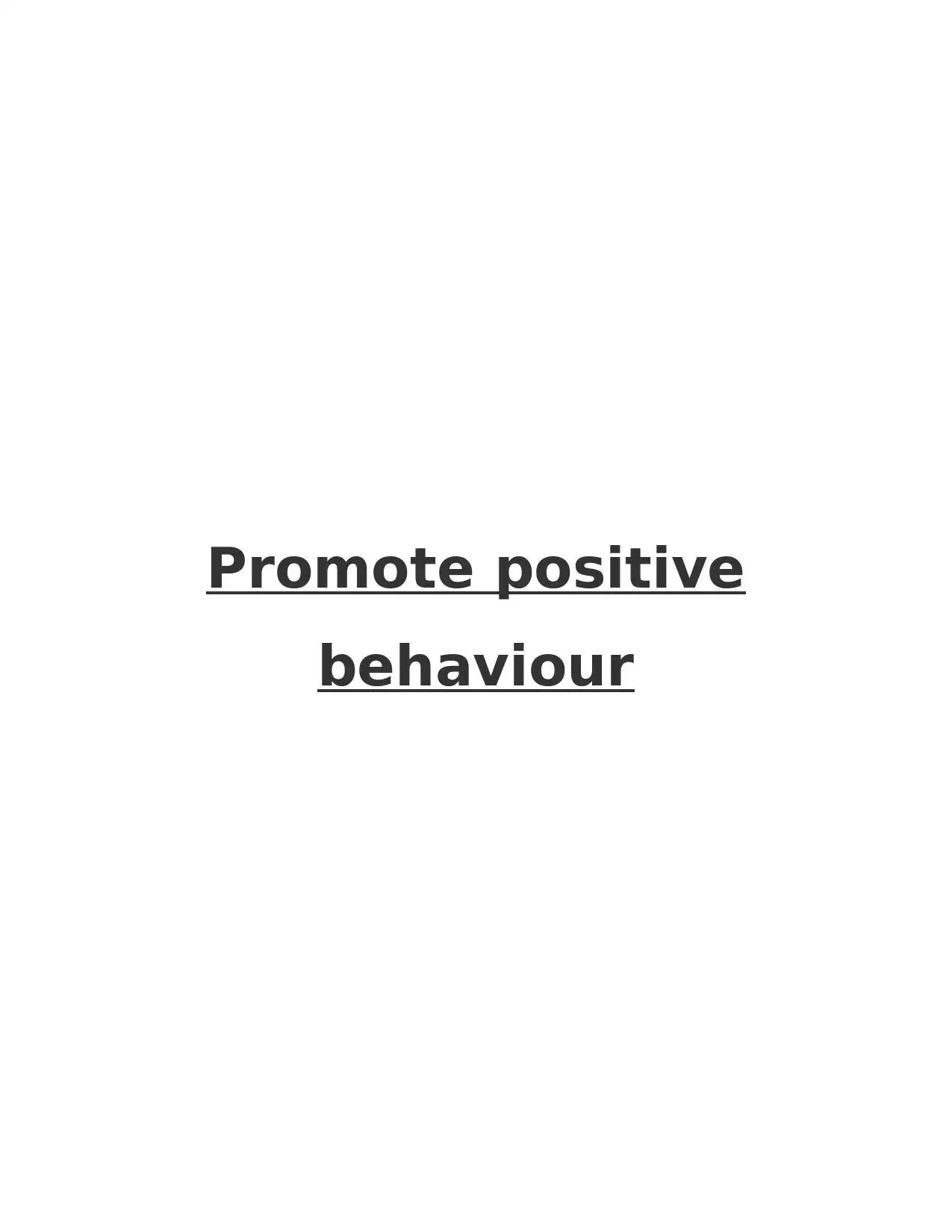
Promote positive
behaviour
behaviour
Secure Best Marks with AI Grader
Need help grading? Try our AI Grader for instant feedback on your assignments.
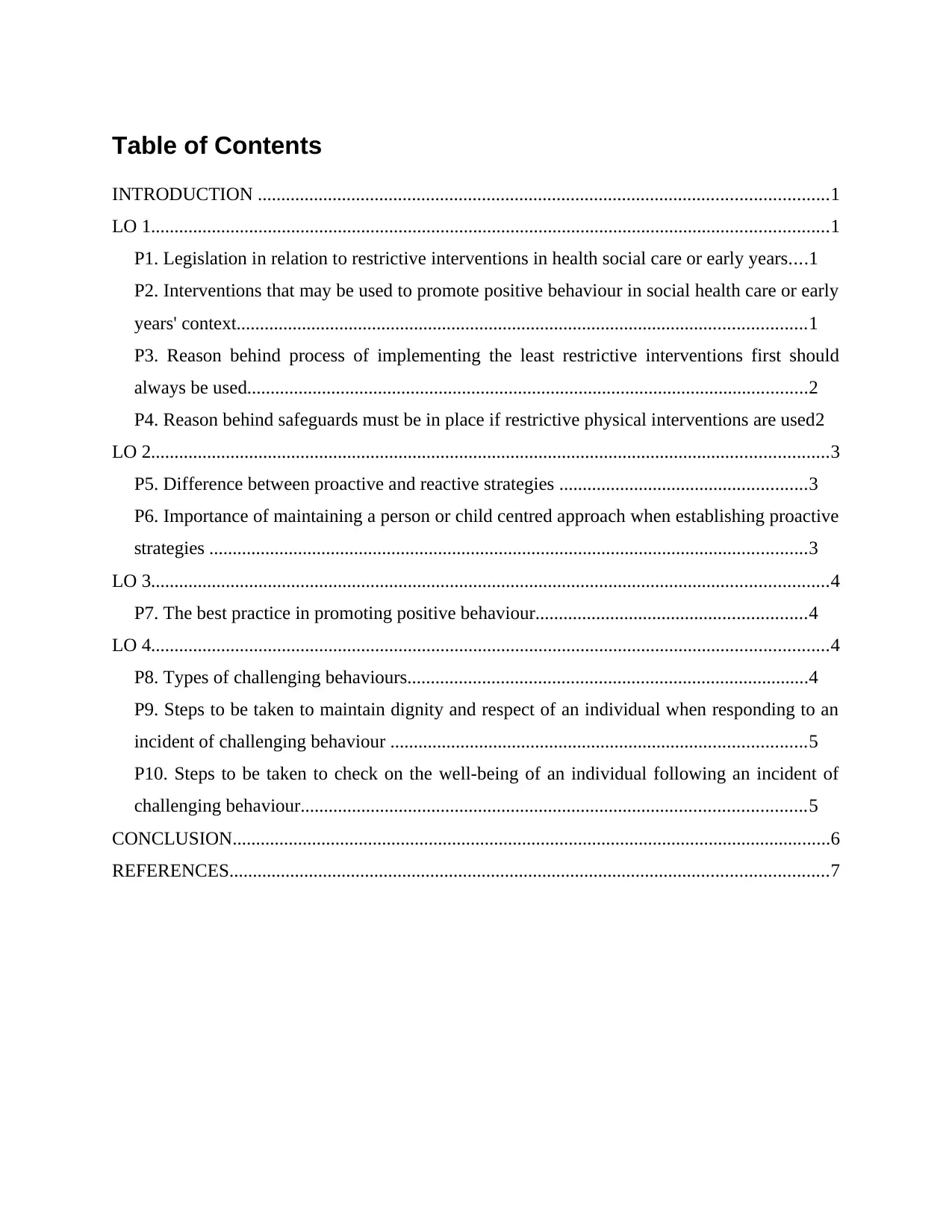
Table of Contents
INTRODUCTION ..........................................................................................................................1
LO 1.................................................................................................................................................1
P1. Legislation in relation to restrictive interventions in health social care or early years....1
P2. Interventions that may be used to promote positive behaviour in social health care or early
years' context..........................................................................................................................1
P3. Reason behind process of implementing the least restrictive interventions first should
always be used........................................................................................................................2
P4. Reason behind safeguards must be in place if restrictive physical interventions are used2
LO 2.................................................................................................................................................3
P5. Difference between proactive and reactive strategies .....................................................3
P6. Importance of maintaining a person or child centred approach when establishing proactive
strategies ................................................................................................................................3
LO 3.................................................................................................................................................4
P7. The best practice in promoting positive behaviour..........................................................4
LO 4.................................................................................................................................................4
P8. Types of challenging behaviours......................................................................................4
P9. Steps to be taken to maintain dignity and respect of an individual when responding to an
incident of challenging behaviour .........................................................................................5
P10. Steps to be taken to check on the well-being of an individual following an incident of
challenging behaviour............................................................................................................5
CONCLUSION................................................................................................................................6
REFERENCES................................................................................................................................7
INTRODUCTION ..........................................................................................................................1
LO 1.................................................................................................................................................1
P1. Legislation in relation to restrictive interventions in health social care or early years....1
P2. Interventions that may be used to promote positive behaviour in social health care or early
years' context..........................................................................................................................1
P3. Reason behind process of implementing the least restrictive interventions first should
always be used........................................................................................................................2
P4. Reason behind safeguards must be in place if restrictive physical interventions are used2
LO 2.................................................................................................................................................3
P5. Difference between proactive and reactive strategies .....................................................3
P6. Importance of maintaining a person or child centred approach when establishing proactive
strategies ................................................................................................................................3
LO 3.................................................................................................................................................4
P7. The best practice in promoting positive behaviour..........................................................4
LO 4.................................................................................................................................................4
P8. Types of challenging behaviours......................................................................................4
P9. Steps to be taken to maintain dignity and respect of an individual when responding to an
incident of challenging behaviour .........................................................................................5
P10. Steps to be taken to check on the well-being of an individual following an incident of
challenging behaviour............................................................................................................5
CONCLUSION................................................................................................................................6
REFERENCES................................................................................................................................7
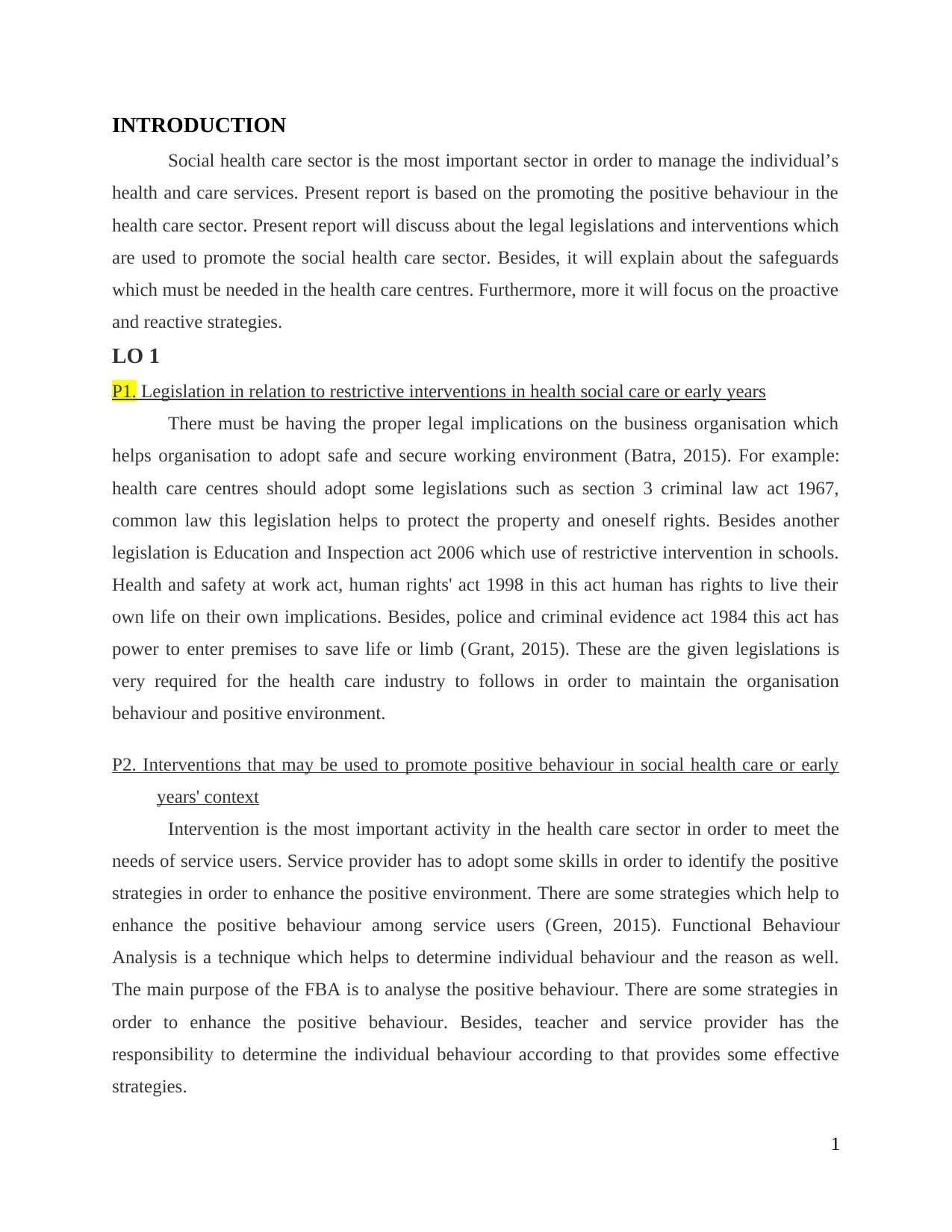
INTRODUCTION
Social health care sector is the most important sector in order to manage the individual’s
health and care services. Present report is based on the promoting the positive behaviour in the
health care sector. Present report will discuss about the legal legislations and interventions which
are used to promote the social health care sector. Besides, it will explain about the safeguards
which must be needed in the health care centres. Furthermore, more it will focus on the proactive
and reactive strategies.
LO 1
P1. Legislation in relation to restrictive interventions in health social care or early years
There must be having the proper legal implications on the business organisation which
helps organisation to adopt safe and secure working environment (Batra, 2015). For example:
health care centres should adopt some legislations such as section 3 criminal law act 1967,
common law this legislation helps to protect the property and oneself rights. Besides another
legislation is Education and Inspection act 2006 which use of restrictive intervention in schools.
Health and safety at work act, human rights' act 1998 in this act human has rights to live their
own life on their own implications. Besides, police and criminal evidence act 1984 this act has
power to enter premises to save life or limb (Grant, 2015). These are the given legislations is
very required for the health care industry to follows in order to maintain the organisation
behaviour and positive environment.
P2. Interventions that may be used to promote positive behaviour in social health care or early
years' context
Intervention is the most important activity in the health care sector in order to meet the
needs of service users. Service provider has to adopt some skills in order to identify the positive
strategies in order to enhance the positive environment. There are some strategies which help to
enhance the positive behaviour among service users (Green, 2015). Functional Behaviour
Analysis is a technique which helps to determine individual behaviour and the reason as well.
The main purpose of the FBA is to analyse the positive behaviour. There are some strategies in
order to enhance the positive behaviour. Besides, teacher and service provider has the
responsibility to determine the individual behaviour according to that provides some effective
strategies.
1
Social health care sector is the most important sector in order to manage the individual’s
health and care services. Present report is based on the promoting the positive behaviour in the
health care sector. Present report will discuss about the legal legislations and interventions which
are used to promote the social health care sector. Besides, it will explain about the safeguards
which must be needed in the health care centres. Furthermore, more it will focus on the proactive
and reactive strategies.
LO 1
P1. Legislation in relation to restrictive interventions in health social care or early years
There must be having the proper legal implications on the business organisation which
helps organisation to adopt safe and secure working environment (Batra, 2015). For example:
health care centres should adopt some legislations such as section 3 criminal law act 1967,
common law this legislation helps to protect the property and oneself rights. Besides another
legislation is Education and Inspection act 2006 which use of restrictive intervention in schools.
Health and safety at work act, human rights' act 1998 in this act human has rights to live their
own life on their own implications. Besides, police and criminal evidence act 1984 this act has
power to enter premises to save life or limb (Grant, 2015). These are the given legislations is
very required for the health care industry to follows in order to maintain the organisation
behaviour and positive environment.
P2. Interventions that may be used to promote positive behaviour in social health care or early
years' context
Intervention is the most important activity in the health care sector in order to meet the
needs of service users. Service provider has to adopt some skills in order to identify the positive
strategies in order to enhance the positive environment. There are some strategies which help to
enhance the positive behaviour among service users (Green, 2015). Functional Behaviour
Analysis is a technique which helps to determine individual behaviour and the reason as well.
The main purpose of the FBA is to analyse the positive behaviour. There are some strategies in
order to enhance the positive behaviour. Besides, teacher and service provider has the
responsibility to determine the individual behaviour according to that provides some effective
strategies.
1
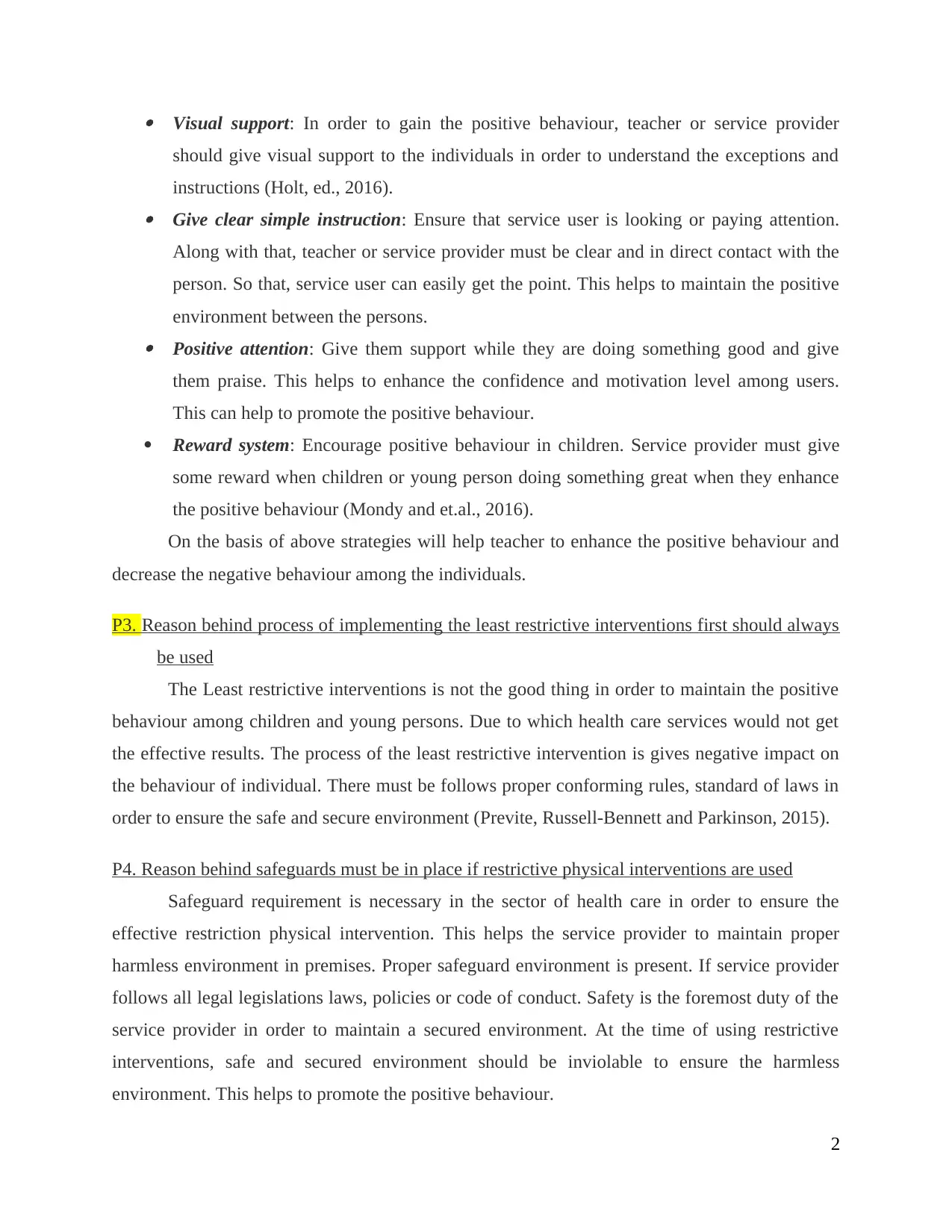
Visual support: In order to gain the positive behaviour, teacher or service provider
should give visual support to the individuals in order to understand the exceptions and
instructions (Holt, ed., 2016). Give clear simple instruction: Ensure that service user is looking or paying attention.
Along with that, teacher or service provider must be clear and in direct contact with the
person. So that, service user can easily get the point. This helps to maintain the positive
environment between the persons. Positive attention: Give them support while they are doing something good and give
them praise. This helps to enhance the confidence and motivation level among users.
This can help to promote the positive behaviour.
Reward system: Encourage positive behaviour in children. Service provider must give
some reward when children or young person doing something great when they enhance
the positive behaviour (Mondy and et.al., 2016).
On the basis of above strategies will help teacher to enhance the positive behaviour and
decrease the negative behaviour among the individuals.
P3. Reason behind process of implementing the least restrictive interventions first should always
be used
The Least restrictive interventions is not the good thing in order to maintain the positive
behaviour among children and young persons. Due to which health care services would not get
the effective results. The process of the least restrictive intervention is gives negative impact on
the behaviour of individual. There must be follows proper conforming rules, standard of laws in
order to ensure the safe and secure environment (Previte, Russell‐Bennett and Parkinson, 2015).
P4. Reason behind safeguards must be in place if restrictive physical interventions are used
Safeguard requirement is necessary in the sector of health care in order to ensure the
effective restriction physical intervention. This helps the service provider to maintain proper
harmless environment in premises. Proper safeguard environment is present. If service provider
follows all legal legislations laws, policies or code of conduct. Safety is the foremost duty of the
service provider in order to maintain a secured environment. At the time of using restrictive
interventions, safe and secured environment should be inviolable to ensure the harmless
environment. This helps to promote the positive behaviour.
2
should give visual support to the individuals in order to understand the exceptions and
instructions (Holt, ed., 2016). Give clear simple instruction: Ensure that service user is looking or paying attention.
Along with that, teacher or service provider must be clear and in direct contact with the
person. So that, service user can easily get the point. This helps to maintain the positive
environment between the persons. Positive attention: Give them support while they are doing something good and give
them praise. This helps to enhance the confidence and motivation level among users.
This can help to promote the positive behaviour.
Reward system: Encourage positive behaviour in children. Service provider must give
some reward when children or young person doing something great when they enhance
the positive behaviour (Mondy and et.al., 2016).
On the basis of above strategies will help teacher to enhance the positive behaviour and
decrease the negative behaviour among the individuals.
P3. Reason behind process of implementing the least restrictive interventions first should always
be used
The Least restrictive interventions is not the good thing in order to maintain the positive
behaviour among children and young persons. Due to which health care services would not get
the effective results. The process of the least restrictive intervention is gives negative impact on
the behaviour of individual. There must be follows proper conforming rules, standard of laws in
order to ensure the safe and secure environment (Previte, Russell‐Bennett and Parkinson, 2015).
P4. Reason behind safeguards must be in place if restrictive physical interventions are used
Safeguard requirement is necessary in the sector of health care in order to ensure the
effective restriction physical intervention. This helps the service provider to maintain proper
harmless environment in premises. Proper safeguard environment is present. If service provider
follows all legal legislations laws, policies or code of conduct. Safety is the foremost duty of the
service provider in order to maintain a secured environment. At the time of using restrictive
interventions, safe and secured environment should be inviolable to ensure the harmless
environment. This helps to promote the positive behaviour.
2
Secure Best Marks with AI Grader
Need help grading? Try our AI Grader for instant feedback on your assignments.
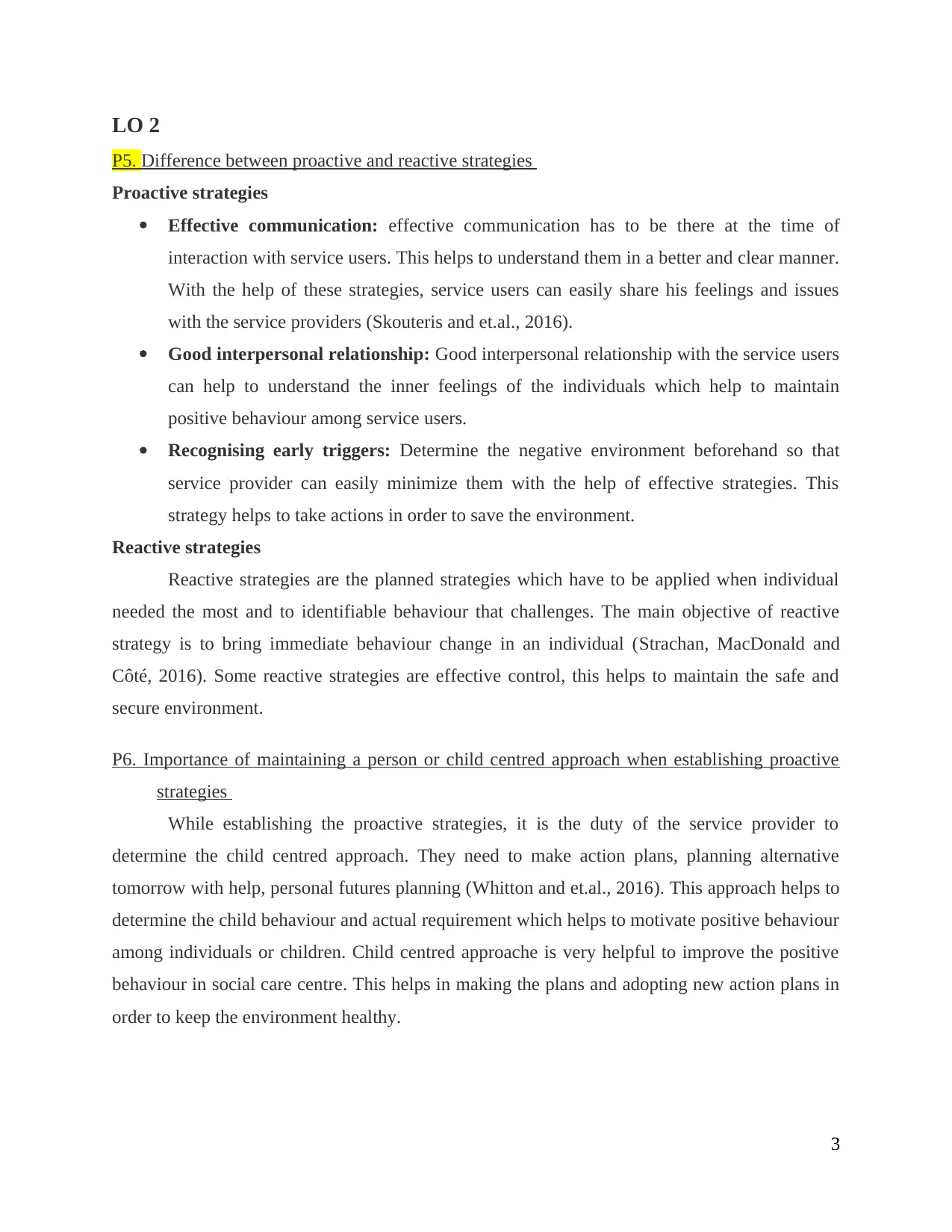
LO 2
P5. Difference between proactive and reactive strategies
Proactive strategies
Effective communication: effective communication has to be there at the time of
interaction with service users. This helps to understand them in a better and clear manner.
With the help of these strategies, service users can easily share his feelings and issues
with the service providers (Skouteris and et.al., 2016).
Good interpersonal relationship: Good interpersonal relationship with the service users
can help to understand the inner feelings of the individuals which help to maintain
positive behaviour among service users.
Recognising early triggers: Determine the negative environment beforehand so that
service provider can easily minimize them with the help of effective strategies. This
strategy helps to take actions in order to save the environment.
Reactive strategies
Reactive strategies are the planned strategies which have to be applied when individual
needed the most and to identifiable behaviour that challenges. The main objective of reactive
strategy is to bring immediate behaviour change in an individual (Strachan, MacDonald and
Côté, 2016). Some reactive strategies are effective control, this helps to maintain the safe and
secure environment.
P6. Importance of maintaining a person or child centred approach when establishing proactive
strategies
While establishing the proactive strategies, it is the duty of the service provider to
determine the child centred approach. They need to make action plans, planning alternative
tomorrow with help, personal futures planning (Whitton and et.al., 2016). This approach helps to
determine the child behaviour and actual requirement which helps to motivate positive behaviour
among individuals or children. Child centred approache is very helpful to improve the positive
behaviour in social care centre. This helps in making the plans and adopting new action plans in
order to keep the environment healthy.
3
P5. Difference between proactive and reactive strategies
Proactive strategies
Effective communication: effective communication has to be there at the time of
interaction with service users. This helps to understand them in a better and clear manner.
With the help of these strategies, service users can easily share his feelings and issues
with the service providers (Skouteris and et.al., 2016).
Good interpersonal relationship: Good interpersonal relationship with the service users
can help to understand the inner feelings of the individuals which help to maintain
positive behaviour among service users.
Recognising early triggers: Determine the negative environment beforehand so that
service provider can easily minimize them with the help of effective strategies. This
strategy helps to take actions in order to save the environment.
Reactive strategies
Reactive strategies are the planned strategies which have to be applied when individual
needed the most and to identifiable behaviour that challenges. The main objective of reactive
strategy is to bring immediate behaviour change in an individual (Strachan, MacDonald and
Côté, 2016). Some reactive strategies are effective control, this helps to maintain the safe and
secure environment.
P6. Importance of maintaining a person or child centred approach when establishing proactive
strategies
While establishing the proactive strategies, it is the duty of the service provider to
determine the child centred approach. They need to make action plans, planning alternative
tomorrow with help, personal futures planning (Whitton and et.al., 2016). This approach helps to
determine the child behaviour and actual requirement which helps to motivate positive behaviour
among individuals or children. Child centred approache is very helpful to improve the positive
behaviour in social care centre. This helps in making the plans and adopting new action plans in
order to keep the environment healthy.
3
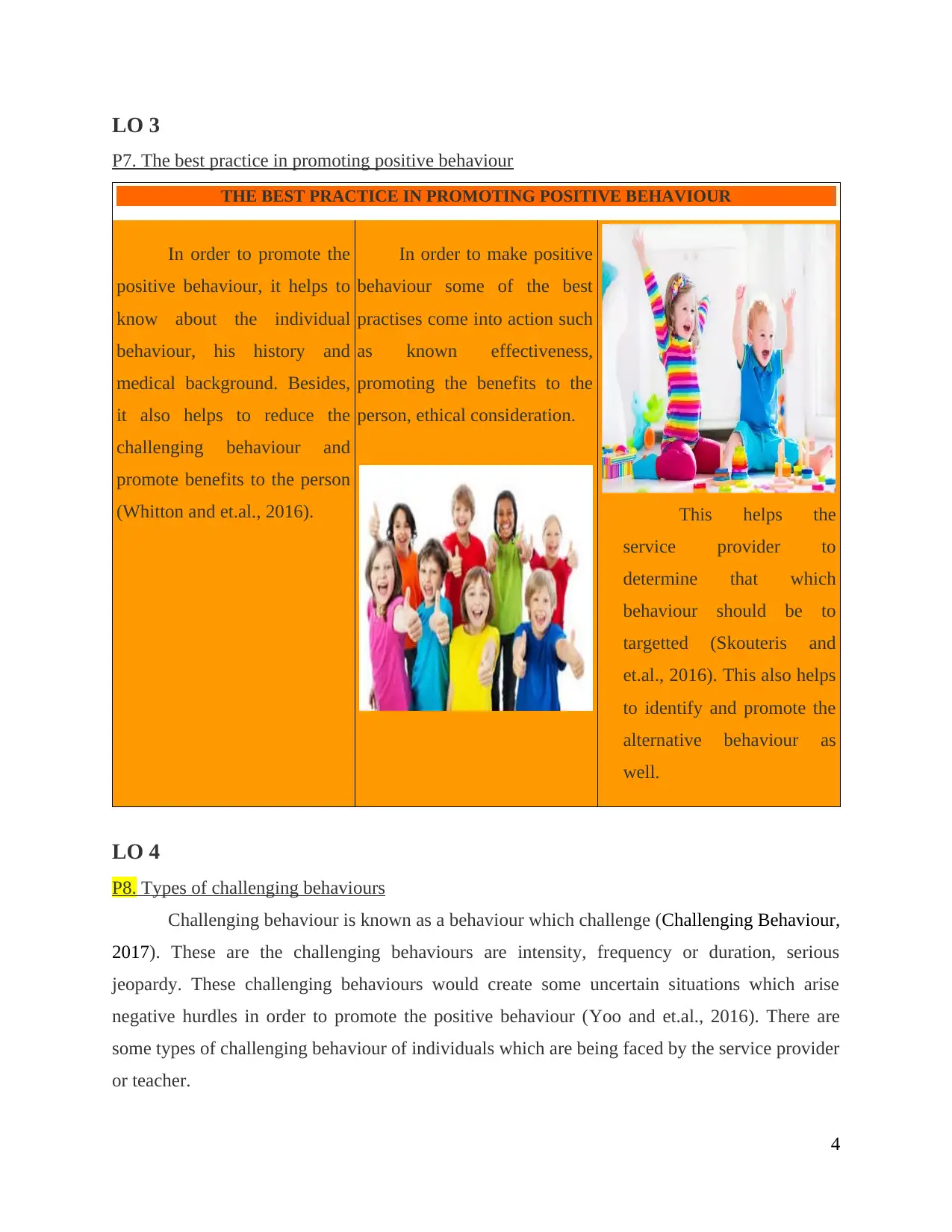
LO 3
P7. The best practice in promoting positive behaviour
THE BEST PRACTICE IN PROMOTING POSITIVE BEHAVIOUR
In order to promote the
positive behaviour, it helps to
know about the individual
behaviour, his history and
medical background. Besides,
it also helps to reduce the
challenging behaviour and
promote benefits to the person
(Whitton and et.al., 2016).
In order to make positive
behaviour some of the best
practises come into action such
as known effectiveness,
promoting the benefits to the
person, ethical consideration.
This helps the
service provider to
determine that which
behaviour should be to
targetted (Skouteris and
et.al., 2016). This also helps
to identify and promote the
alternative behaviour as
well.
LO 4
P8. Types of challenging behaviours
Challenging behaviour is known as a behaviour which challenge (Challenging Behaviour,
2017). These are the challenging behaviours are intensity, frequency or duration, serious
jeopardy. These challenging behaviours would create some uncertain situations which arise
negative hurdles in order to promote the positive behaviour (Yoo and et.al., 2016). There are
some types of challenging behaviour of individuals which are being faced by the service provider
or teacher.
4
P7. The best practice in promoting positive behaviour
THE BEST PRACTICE IN PROMOTING POSITIVE BEHAVIOUR
In order to promote the
positive behaviour, it helps to
know about the individual
behaviour, his history and
medical background. Besides,
it also helps to reduce the
challenging behaviour and
promote benefits to the person
(Whitton and et.al., 2016).
In order to make positive
behaviour some of the best
practises come into action such
as known effectiveness,
promoting the benefits to the
person, ethical consideration.
This helps the
service provider to
determine that which
behaviour should be to
targetted (Skouteris and
et.al., 2016). This also helps
to identify and promote the
alternative behaviour as
well.
LO 4
P8. Types of challenging behaviours
Challenging behaviour is known as a behaviour which challenge (Challenging Behaviour,
2017). These are the challenging behaviours are intensity, frequency or duration, serious
jeopardy. These challenging behaviours would create some uncertain situations which arise
negative hurdles in order to promote the positive behaviour (Yoo and et.al., 2016). There are
some types of challenging behaviour of individuals which are being faced by the service provider
or teacher.
4
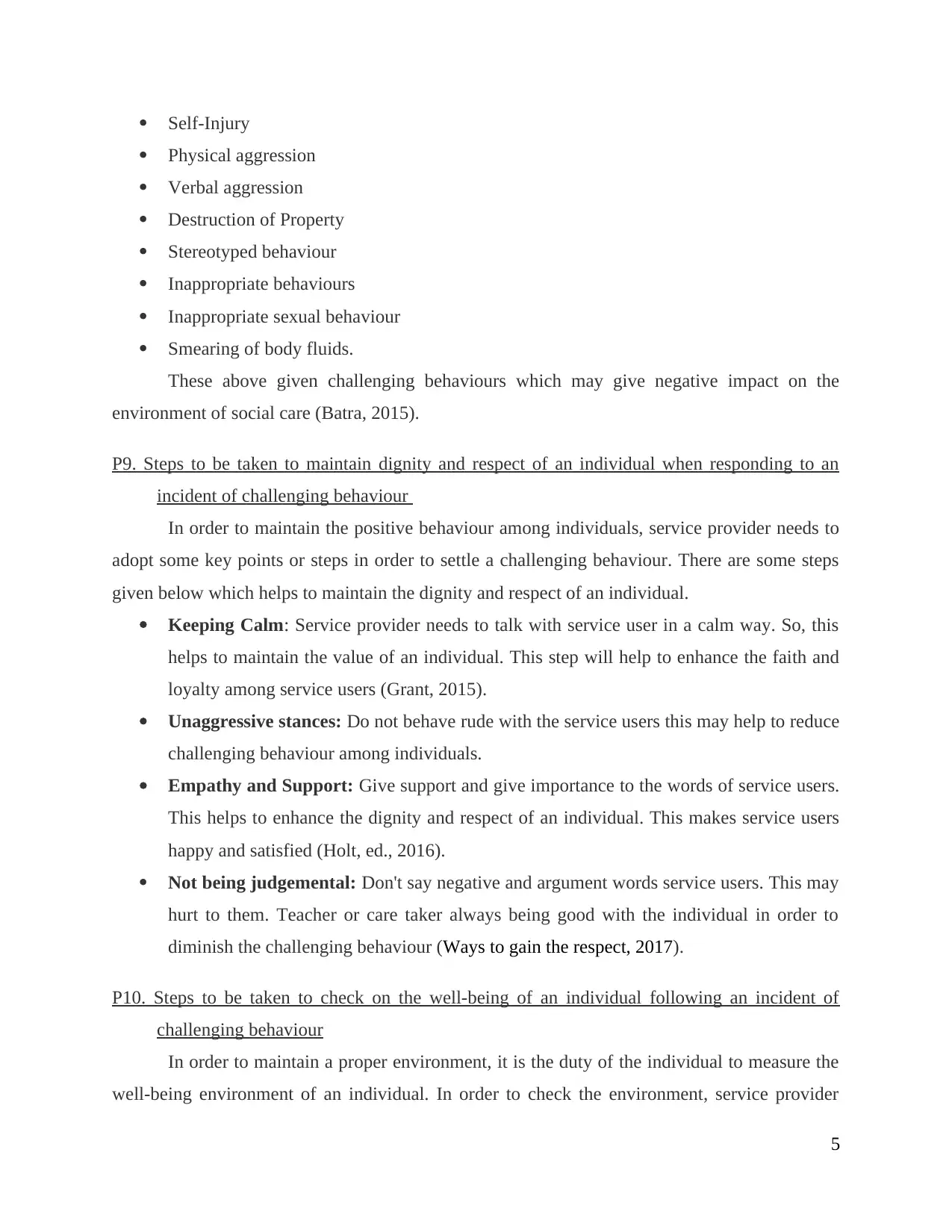
Self-Injury
Physical aggression
Verbal aggression
Destruction of Property
Stereotyped behaviour
Inappropriate behaviours
Inappropriate sexual behaviour
Smearing of body fluids.
These above given challenging behaviours which may give negative impact on the
environment of social care (Batra, 2015).
P9. Steps to be taken to maintain dignity and respect of an individual when responding to an
incident of challenging behaviour
In order to maintain the positive behaviour among individuals, service provider needs to
adopt some key points or steps in order to settle a challenging behaviour. There are some steps
given below which helps to maintain the dignity and respect of an individual.
Keeping Calm: Service provider needs to talk with service user in a calm way. So, this
helps to maintain the value of an individual. This step will help to enhance the faith and
loyalty among service users (Grant, 2015).
Unaggressive stances: Do not behave rude with the service users this may help to reduce
challenging behaviour among individuals.
Empathy and Support: Give support and give importance to the words of service users.
This helps to enhance the dignity and respect of an individual. This makes service users
happy and satisfied (Holt, ed., 2016).
Not being judgemental: Don't say negative and argument words service users. This may
hurt to them. Teacher or care taker always being good with the individual in order to
diminish the challenging behaviour (Ways to gain the respect, 2017).
P10. Steps to be taken to check on the well-being of an individual following an incident of
challenging behaviour
In order to maintain a proper environment, it is the duty of the individual to measure the
well-being environment of an individual. In order to check the environment, service provider
5
Physical aggression
Verbal aggression
Destruction of Property
Stereotyped behaviour
Inappropriate behaviours
Inappropriate sexual behaviour
Smearing of body fluids.
These above given challenging behaviours which may give negative impact on the
environment of social care (Batra, 2015).
P9. Steps to be taken to maintain dignity and respect of an individual when responding to an
incident of challenging behaviour
In order to maintain the positive behaviour among individuals, service provider needs to
adopt some key points or steps in order to settle a challenging behaviour. There are some steps
given below which helps to maintain the dignity and respect of an individual.
Keeping Calm: Service provider needs to talk with service user in a calm way. So, this
helps to maintain the value of an individual. This step will help to enhance the faith and
loyalty among service users (Grant, 2015).
Unaggressive stances: Do not behave rude with the service users this may help to reduce
challenging behaviour among individuals.
Empathy and Support: Give support and give importance to the words of service users.
This helps to enhance the dignity and respect of an individual. This makes service users
happy and satisfied (Holt, ed., 2016).
Not being judgemental: Don't say negative and argument words service users. This may
hurt to them. Teacher or care taker always being good with the individual in order to
diminish the challenging behaviour (Ways to gain the respect, 2017).
P10. Steps to be taken to check on the well-being of an individual following an incident of
challenging behaviour
In order to maintain a proper environment, it is the duty of the individual to measure the
well-being environment of an individual. In order to check the environment, service provider
5
Paraphrase This Document
Need a fresh take? Get an instant paraphrase of this document with our AI Paraphraser
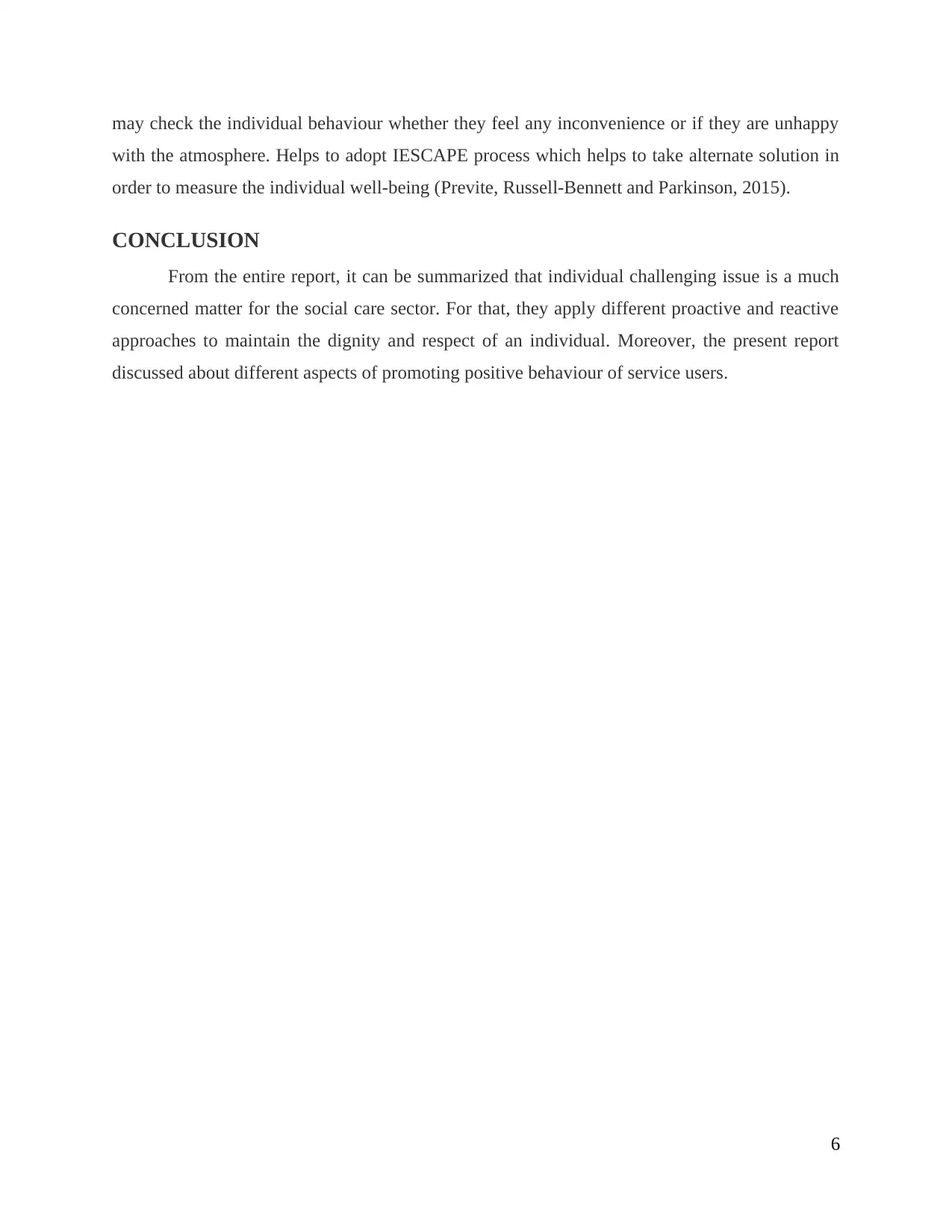
may check the individual behaviour whether they feel any inconvenience or if they are unhappy
with the atmosphere. Helps to adopt IESCAPE process which helps to take alternate solution in
order to measure the individual well-being (Previte, Russell‐Bennett and Parkinson, 2015).
CONCLUSION
From the entire report, it can be summarized that individual challenging issue is a much
concerned matter for the social care sector. For that, they apply different proactive and reactive
approaches to maintain the dignity and respect of an individual. Moreover, the present report
discussed about different aspects of promoting positive behaviour of service users.
6
with the atmosphere. Helps to adopt IESCAPE process which helps to take alternate solution in
order to measure the individual well-being (Previte, Russell‐Bennett and Parkinson, 2015).
CONCLUSION
From the entire report, it can be summarized that individual challenging issue is a much
concerned matter for the social care sector. For that, they apply different proactive and reactive
approaches to maintain the dignity and respect of an individual. Moreover, the present report
discussed about different aspects of promoting positive behaviour of service users.
6
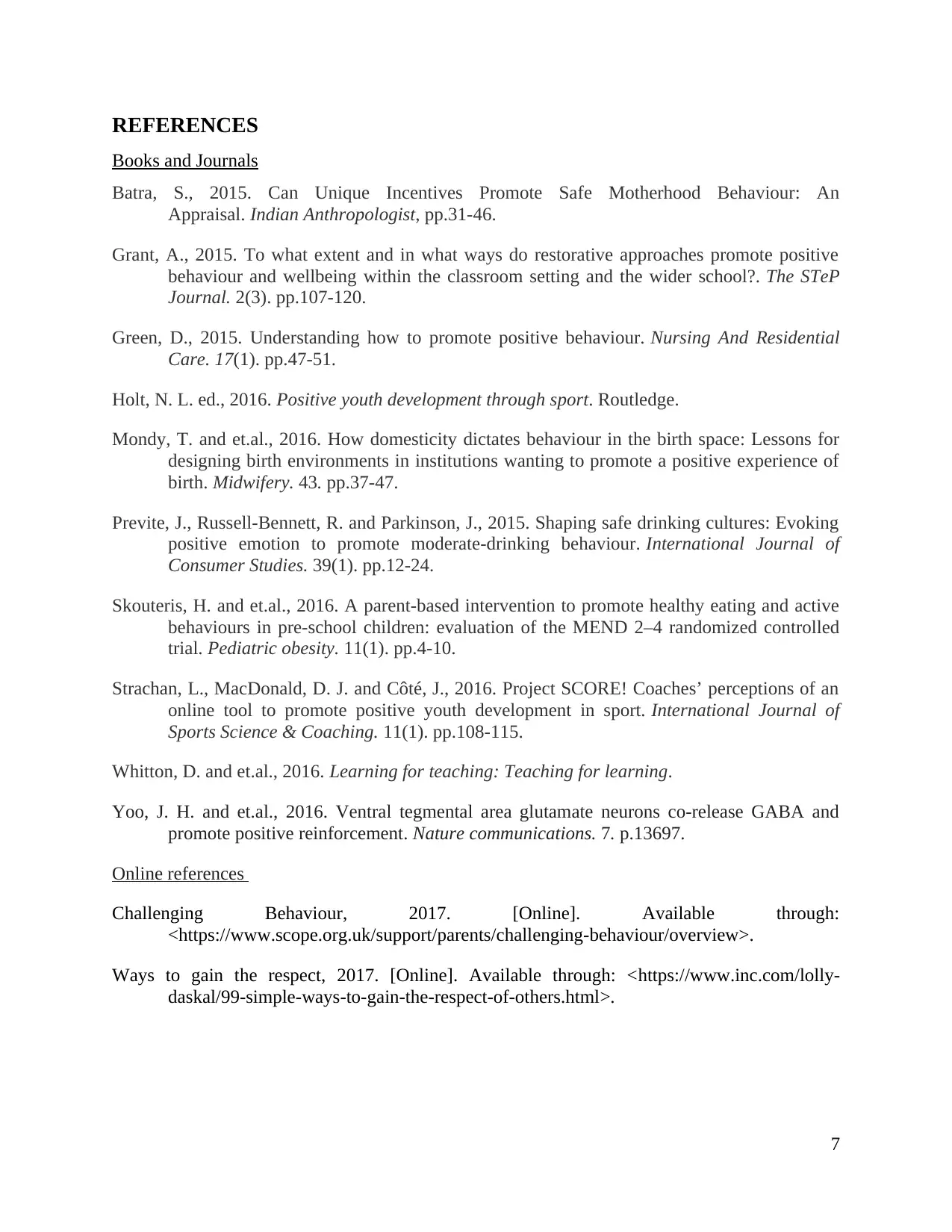
REFERENCES
Books and Journals
Batra, S., 2015. Can Unique Incentives Promote Safe Motherhood Behaviour: An
Appraisal. Indian Anthropologist, pp.31-46.
Grant, A., 2015. To what extent and in what ways do restorative approaches promote positive
behaviour and wellbeing within the classroom setting and the wider school?. The STeP
Journal. 2(3). pp.107-120.
Green, D., 2015. Understanding how to promote positive behaviour. Nursing And Residential
Care. 17(1). pp.47-51.
Holt, N. L. ed., 2016. Positive youth development through sport. Routledge.
Mondy, T. and et.al., 2016. How domesticity dictates behaviour in the birth space: Lessons for
designing birth environments in institutions wanting to promote a positive experience of
birth. Midwifery. 43. pp.37-47.
Previte, J., Russell‐Bennett, R. and Parkinson, J., 2015. Shaping safe drinking cultures: Evoking
positive emotion to promote moderate‐drinking behaviour. International Journal of
Consumer Studies. 39(1). pp.12-24.
Skouteris, H. and et.al., 2016. A parent‐based intervention to promote healthy eating and active
behaviours in pre‐school children: evaluation of the MEND 2–4 randomized controlled
trial. Pediatric obesity. 11(1). pp.4-10.
Strachan, L., MacDonald, D. J. and Côté, J., 2016. Project SCORE! Coaches’ perceptions of an
online tool to promote positive youth development in sport. International Journal of
Sports Science & Coaching. 11(1). pp.108-115.
Whitton, D. and et.al., 2016. Learning for teaching: Teaching for learning.
Yoo, J. H. and et.al., 2016. Ventral tegmental area glutamate neurons co-release GABA and
promote positive reinforcement. Nature communications. 7. p.13697.
Online references
Challenging Behaviour, 2017. [Online]. Available through:
<https://www.scope.org.uk/support/parents/challenging-behaviour/overview>.
Ways to gain the respect, 2017. [Online]. Available through: <https://www.inc.com/lolly-
daskal/99-simple-ways-to-gain-the-respect-of-others.html>.
7
Books and Journals
Batra, S., 2015. Can Unique Incentives Promote Safe Motherhood Behaviour: An
Appraisal. Indian Anthropologist, pp.31-46.
Grant, A., 2015. To what extent and in what ways do restorative approaches promote positive
behaviour and wellbeing within the classroom setting and the wider school?. The STeP
Journal. 2(3). pp.107-120.
Green, D., 2015. Understanding how to promote positive behaviour. Nursing And Residential
Care. 17(1). pp.47-51.
Holt, N. L. ed., 2016. Positive youth development through sport. Routledge.
Mondy, T. and et.al., 2016. How domesticity dictates behaviour in the birth space: Lessons for
designing birth environments in institutions wanting to promote a positive experience of
birth. Midwifery. 43. pp.37-47.
Previte, J., Russell‐Bennett, R. and Parkinson, J., 2015. Shaping safe drinking cultures: Evoking
positive emotion to promote moderate‐drinking behaviour. International Journal of
Consumer Studies. 39(1). pp.12-24.
Skouteris, H. and et.al., 2016. A parent‐based intervention to promote healthy eating and active
behaviours in pre‐school children: evaluation of the MEND 2–4 randomized controlled
trial. Pediatric obesity. 11(1). pp.4-10.
Strachan, L., MacDonald, D. J. and Côté, J., 2016. Project SCORE! Coaches’ perceptions of an
online tool to promote positive youth development in sport. International Journal of
Sports Science & Coaching. 11(1). pp.108-115.
Whitton, D. and et.al., 2016. Learning for teaching: Teaching for learning.
Yoo, J. H. and et.al., 2016. Ventral tegmental area glutamate neurons co-release GABA and
promote positive reinforcement. Nature communications. 7. p.13697.
Online references
Challenging Behaviour, 2017. [Online]. Available through:
<https://www.scope.org.uk/support/parents/challenging-behaviour/overview>.
Ways to gain the respect, 2017. [Online]. Available through: <https://www.inc.com/lolly-
daskal/99-simple-ways-to-gain-the-respect-of-others.html>.
7
1 out of 9
Related Documents
Your All-in-One AI-Powered Toolkit for Academic Success.
+13062052269
info@desklib.com
Available 24*7 on WhatsApp / Email
![[object Object]](/_next/static/media/star-bottom.7253800d.svg)
Unlock your academic potential
© 2024 | Zucol Services PVT LTD | All rights reserved.





